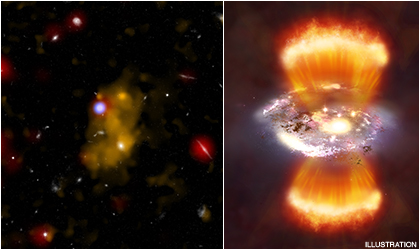Hunting For the Most Distant Galaxy Cluster
Submitted by chandra on Tue, 2016-08-30 10:39
Tao Wang
We are pleased to welcome Dr. Tao Wang as a guest blogger. Tao is the first author of a paper that is the subject of our latest press release, about an extremely distant galaxy cluster. Tao is now a postdoc in CEA/Saclay, France, working with Dr. David Elbaz on high-redshift galaxies and galaxy clusters, and received a PhD in astrophysics from Nanjing University, China in 2012. During his PhD, he worked for two years in the Harvard-Smithsonian Center for Astrophysics and then worked as an associate researcher back in Nanjing University for one year before starting his postdoctoral work at CEA/Saclay in 2013.
Galaxy clusters are the largest known gravitationally bound structures in the universe and usually consist of hundreds of galaxies distributed in a relatively small area a few million light-years across. One of the most prominent features of clusters is the presence of a predominant population of massive, elliptical galaxies in the cluster core. These galaxies are among the most massive galaxies in the universe and are believed to have rapidly formed their stars a long time ago. However, how these galaxies formed and why have they stopped forming new stars remain mysteries. Solving these mysteries is essential to our understanding of both galaxy and cluster formation. To answer these questions, the key is to search for and study galaxy clusters (or their progenitors) in the early universe, right when they form.





